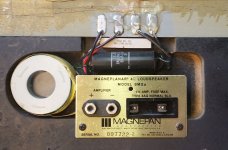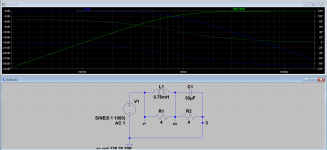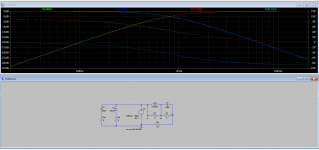I've got a set of Magnepan SMGa speakers that I'd like to biamp, but I'm pretty well clueless as to how to do it.
How to wire it for biamplificaton:
First, disconnect the existing crossover.
Then do I keep the inductor in parallel with the mid/woofer?
And keep the capacitor in parallel with the tweeter?
Then, when using an active crossover, what frequency makes sense to cross over at?
Thanks!
How to wire it for biamplificaton:
First, disconnect the existing crossover.
Then do I keep the inductor in parallel with the mid/woofer?
And keep the capacitor in parallel with the tweeter?
Then, when using an active crossover, what frequency makes sense to cross over at?
Thanks!
Attachments
With passive bi-amping you need to separate the XO into 2 discrete XOs and drive each with its own amplifier. The passive XO is a series XO so a new XO configuration would be needed
With an active XO (real bi-amping) you eliminate the XO completely. The starting poing for setting your active XO is to get as close to the passive XO as possible (passive is 1st order).
dave
With an active XO (real bi-amping) you eliminate the XO completely. The starting poing for setting your active XO is to get as close to the passive XO as possible (passive is 1st order).
dave
Dave -
Yes, real bi-amping, from pre to active crossover to two power amps, one for bass/mid and one for tweeters.
So, remove the passive XO from the Magnepans completely, and redo the speaker connections to allow direct connection from the each amp to each section of the SMGa's.
You said "The starting poing for setting your active XO is to get as close to the passive XO as possible (passive is 1st order)." How do I determine that? What might a guess of a good starting point be?
Thanks.
MG
Yes, real bi-amping, from pre to active crossover to two power amps, one for bass/mid and one for tweeters.
So, remove the passive XO from the Magnepans completely, and redo the speaker connections to allow direct connection from the each amp to each section of the SMGa's.
You said "The starting poing for setting your active XO is to get as close to the passive XO as possible (passive is 1st order)." How do I determine that? What might a guess of a good starting point be?
Thanks.
MG
I would suggest minidsp. As a start. It allows you to change crossover frequency, slopes, delays, levels...on the fly, while listening. Its cheap too. Sounds ok, once you get all sorted out, you can upgrade. Plus its parametric eq, you can use it to correct room.
Just a suggestion, do what suits you.
Just a suggestion, do what suits you.
So, remove the passive XO from the Magnepans completely, and redo the speaker connections to allow direct connection from the each amp to each section of the SMGa’s.
Yes
You said "The starting poing for setting your active XO is to get as close to the passive XO as possible (passive is 1st order)." How do I determine that? What might a guess of a good starting point be?
Manufacturer specs, reviews, email Magnepan.
dave
Does this suggest 800hz?
You might be able to use text-book XO values as a 1st pass guess. You’d really need to have impedance plots of your speakers sans Cos to get more accurate impedance values.
dave
You guys are clearly more advanced than I am, but I ask the Tribal Elders and Wise Ones in order to learn.
Here's a very basic question: Is it worth it? I have read many places that bi-amping is worth exploring.
I am limimted in my equipment and $$ to upgrade much at this time, so my idea was this: CD Player/Aux into NAD 3225PE, Preamp out of NAD NAD 3225PE into active crossover, highs out of active crossover back into NAD 3225PE and speakers direct to Maggie tweets, lows out of active crossver into NAD 2100PE and speakers direct to Maggie lows/mid. (Alernately, into vintage Altecs, driven by Magnavox 8802 and 175).
I now drive the Magnepan SMGa speakers this the NAD 2100 PE alone, about 75 watts into 4 ohms to drive SMGa factory passive crossover speakers
Biamping suggests more power to the speakers. Active biamp = NAD 3225PE (About 30 watts into 4 ohms) for the high range, NAD 2100 (About 75 watts into 4 ohms) for the lows. Net difference: From 75 watts to passive crossover to 105 watts active crossover.
Or should I just sell off my old NAD stuff and get a Denon, Sony, Yamaha, Oinko, Pioneer AV reciever puting out about 140 to 150 watts (8 ohms), or find some 200W beast on Craigslist for cheap?
Here's a very basic question: Is it worth it? I have read many places that bi-amping is worth exploring.
I am limimted in my equipment and $$ to upgrade much at this time, so my idea was this: CD Player/Aux into NAD 3225PE, Preamp out of NAD NAD 3225PE into active crossover, highs out of active crossover back into NAD 3225PE and speakers direct to Maggie tweets, lows out of active crossver into NAD 2100PE and speakers direct to Maggie lows/mid. (Alernately, into vintage Altecs, driven by Magnavox 8802 and 175).
I now drive the Magnepan SMGa speakers this the NAD 2100 PE alone, about 75 watts into 4 ohms to drive SMGa factory passive crossover speakers
Biamping suggests more power to the speakers. Active biamp = NAD 3225PE (About 30 watts into 4 ohms) for the high range, NAD 2100 (About 75 watts into 4 ohms) for the lows. Net difference: From 75 watts to passive crossover to 105 watts active crossover.
Or should I just sell off my old NAD stuff and get a Denon, Sony, Yamaha, Oinko, Pioneer AV reciever puting out about 140 to 150 watts (8 ohms), or find some 200W beast on Craigslist for cheap?
Using the NADs is a fine approach. We sold a lot of NAD3020 with the promise of easy bi-amping in the future.
dave
dave
As others have alluded you need to remove all of the existing XO parts. The tweeter is somewhat fragile so the fuse should be retained.
I have include a simulation of the current XO response. Because the drivers look predominantly resistive the response is pretty close to text first order network amplitude and phase response.
First graph is just the series XO and drivers, the second is an overlay with a classic first order 2 way xo. There is no difference.
Looks like first order crossover at 800Hz would be fine.
I have include a simulation of the current XO response. Because the drivers look predominantly resistive the response is pretty close to text first order network amplitude and phase response.
First graph is just the series XO and drivers, the second is an overlay with a classic first order 2 way xo. There is no difference.
Looks like first order crossover at 800Hz would be fine.
Attachments
In my (anecdotal only) experience, yes. I converted one of a pair of two-ways to active and thought the passives had a towel draped over the front of the speaker, so second to active. I then converted one two-way to a three-way by adding a mid-range, with the same effect.Here's a very basic question: Is it worth it? I have read many places that bi-amping is worth exploring.
I now run three way actives and when I hear passive speakers, they sound either 'thin', muffled (more in the mid-range), or contrived to sound initially impressive but are tiring and irritating after a short time. Some songs are spectacular with actives, such as Smells Like Teen Spirit as loud as you can bear.
I have ran a pr of the SMGa an other Magnepans ative....as with any speaker ran active.....it can sound better or diff ...but you need more amps, XO....I well say in this case the SMGa with the only series XO used back in the day....An as thay use in all there new speakers made to day.....I an magnepan don't think you can get better sound than the series Ox...less you spend Big money on amps an Xo....
The SMGa is one sweet sounding speaker I had more than one pr upgread the cap an coil...an go to the Magnestand site an get the new Xo Peter Gun uses in his MOD to these SMGa....
But Magnepan dose not sale the tweeter wire repair kit any more, an it the tweeter gose in these over 30 year old babys...well good luck...
All just one mans finding....
The SMGa is one sweet sounding speaker I had more than one pr upgread the cap an coil...an go to the Magnestand site an get the new Xo Peter Gun uses in his MOD to these SMGa....
But Magnepan dose not sale the tweeter wire repair kit any more, an it the tweeter gose in these over 30 year old babys...well good luck...
All just one mans finding....
Many thanks to all, looks likes it's very easy to do. I'm hoping it improves the sound, but if not, easily reversible.
MG
MG
I'm gonna try and bi-amp my smga, desolder main panel connections, solder on new ones to each driver and start off at 1000 hz and play it by ear from there.
Like your minidsp idea, gotta get me one 🙂
Like your minidsp idea, gotta get me one 🙂
kevinkr, that software did you use to generate the graphs?
LTSpice which is here: Linear Technology - Design Simulation and Device Models
- Status
- Not open for further replies.
- Home
- Loudspeakers
- Planars & Exotics
- How to modify SMGa to Active Crossover?



